Creating colored clay slip is an enjoyable and versatile way to add decorative elements to your pottery projects. Clay slip, a liquid mixture of clay and water, can be tinted with various pigments to achieve a wide range of vibrant colors.
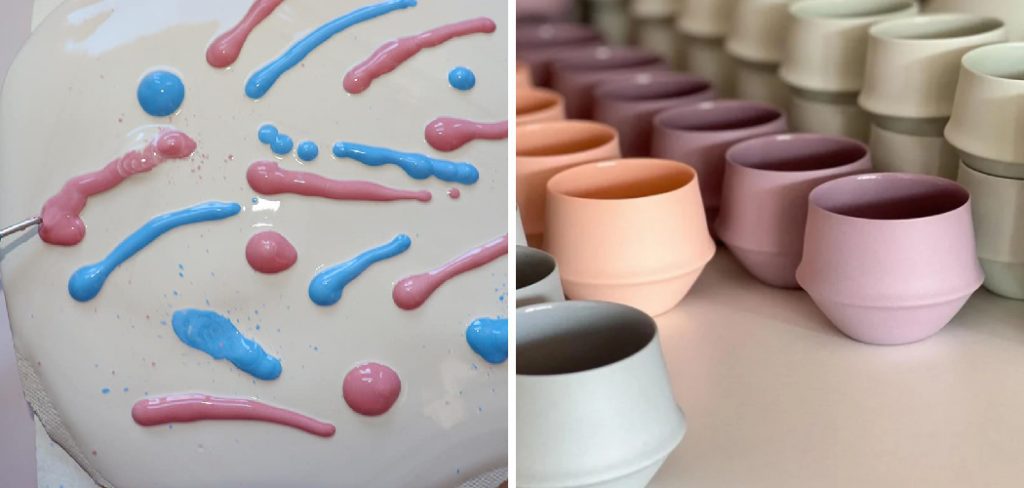
Whether you are a beginner or an experienced ceramic artist, learning how to make colored clay slip will allow you to personalize your creations and bring your artistic visions to life. This guide will walk you through the materials, steps, and tips for producing your own colored clay slip.
What is Colored Clay Slip?
Colored clay slip is a liquid form of clay that is mixed with pigments to add color and decorative details to pottery and ceramic pieces. It is typically applied to the surface of unfired clay, often before the piece is bisque-fired, allowing artists to create intricate designs, patterns, or solid-colored coatings.
The slip adheres to the surface of the clay body, becoming an integral part of the finished ceramic piece during the firing process. The ability to tint clay slip with a variety of pigments makes it a versatile medium, offering endless opportunities for creative expression in ceramic art.
Differences Between Slip, Slurry, and Underglaze
While slip, slurry, and underglaze are all commonly used in pottery and ceramics, they serve different purposes and have distinct characteristics. Understanding these differences is essential for using each effectively in your ceramic projects.
- Slip is a liquefied form of clay that can be used for various decorative techniques, such as painting designs, coating surfaces, or joining clay pieces together. When colored with pigments, slip offers a wide range of artistic possibilities and is applied to unfired clay before bisque firing.
- Slurry, on the other hand, is a thicker mixture of clay and water, often resembling a paste. It is primarily used for practical purposes, such as adhering separate pieces of clay together in a process called scoring and slipping. Unlike colored slip, slurry does not typically contain pigments or serve a decorative role.
- Underglaze is a specialized coating that contains pigments suspended in a binder, designed to provide vibrant and consistent colors to ceramic surfaces. Unlike slip, underglaze is usually applied in thin layers to bisqueware (fired but unglazed clay) and is sealed with a clear or translucent glaze during the final firing. It is ideal for achieving detailed patterns, sharp lines, and smooth finishes on pottery.
By recognizing the unique qualities of slip, slurry, and underglaze, ceramic artists can make informed choices based on the decorative or structural needs of their projects.
10 Methods How to Make Colored Clay Slip
1. Basic Colored Clay Slip Using Ceramic Stains
One of the simplest ways to make colored clay slip is by using ceramic stains. These stains are available in a wide range of vibrant colors and are easy to mix with clay. Start by preparing a smooth, well-mixed clay body and adding water until you achieve the desired consistency for a slip.
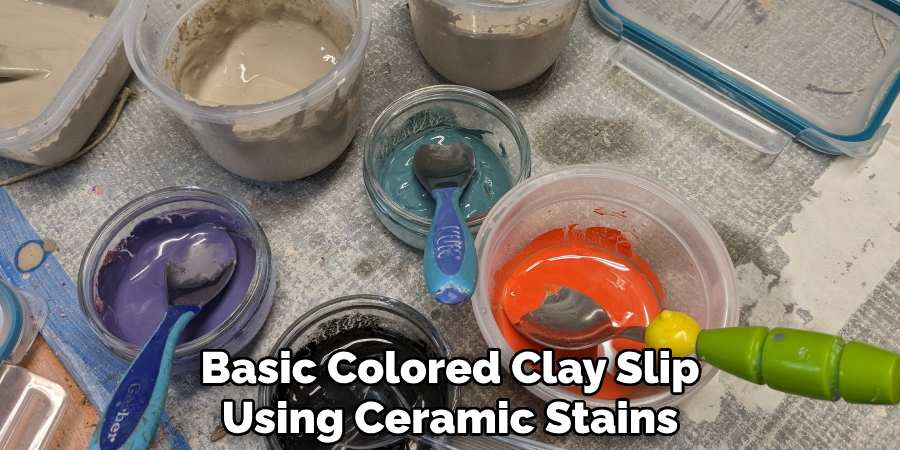
Then, add the ceramic stain of your choice to the wet clay, typically around 10-15% of the weight of the dry clay. Stir the mixture thoroughly to ensure an even distribution of color throughout the slip. This method is ideal for pottery artists looking to add subtle color to their pieces or create a base for further glazing or decoration.
2. Using Oxides to Make Colored Slip
Oxides such as iron oxide, copper oxide, and cobalt oxide are commonly used to create colored slips with earthy tones and rich hues. To make a colored slip with oxides, begin by mixing your chosen clay with water to the desired consistency. Then, add a small amount (usually 5-10% by weight) of the oxide to the clay slurry.
The amount you use will determine the intensity of the color, so start with a small amount and test the result. Iron oxide, for example, will produce warm reddish-brown colors, while copper oxide can create turquoise or green shades.
3. Mixing Colored Slip Using Mason Stains
Mason stains are highly concentrated ceramic pigments that offer a vast spectrum of colors. To make colored clay slip using Mason stains, start by selecting the appropriate stain for your desired color. Mix the stain with water and add it to your clay, starting with a small amount and gradually increasing the quantity until you reach your preferred color intensity.
Typically, Mason stains are mixed at about 5-10% by weight of the dry clay, but experimenting with different amounts will help you achieve the right color depth.
4. Incorporating Natural Pigments into Slip
Natural pigments derived from minerals, plants, or other natural sources can also be used to make colored slip, providing earthy and organic tones. Common natural pigments include ochre, manganese, and umber, all of which create beautiful colors that are perfect for rustic or handmade ceramics.
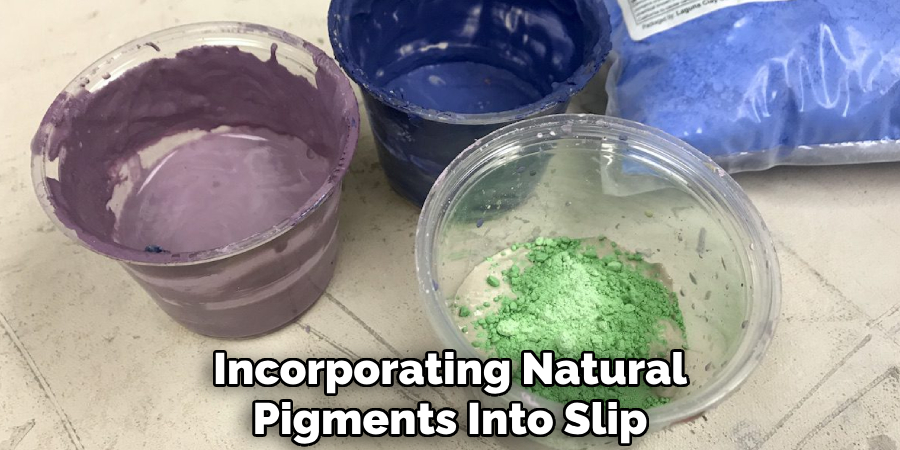
To create a colored slip with natural pigments, start by mixing your clay with water to achieve a creamy consistency. Then, add the natural pigment and stir until fully incorporated. Natural pigments are often less concentrated than ceramic stains or oxides, so you may need to add more pigment to achieve your desired color.
5. Making Colored Slip with Commercial Liquid Stains
Commercial liquid stains are premixed, ready-to-use pigments that can be added to clay to create colored slips quickly and efficiently. These stains come in various hues and are particularly popular for those looking to save time without compromising on color intensity.
To make a colored slip with liquid stains, simply add the commercial stain directly to the clay and water mixture, stirring until the desired color is achieved. Liquid stains tend to be highly concentrated, so a small amount usually suffices.
6. Using Colored Slips for Sgraffito Techniques
Sgraffito is a decorative technique that involves applying a colored slip to a leather-hard clay surface, then scratching or carving designs into the slip to reveal the natural clay underneath. To make a slip for sgraffito, select a colorant (such as oxide, ceramic stain, or natural pigment) and mix it with your clay and water to form a smooth slip.
Apply the slip evenly onto the leather-hard surface of your pottery, and then use carving tools to create your design. The slip’s color contrasts beautifully with the exposed clay, making it an excellent choice for intricate patterns and fine details.
7. Layering Colored Slips for a Multicolored Effect
Creating a layered colored slip effect involves applying multiple layers of differently colored slips on the surface of a clay body. To achieve this, prepare several colored slips by using different stains or oxides, and apply one layer of slip to your pottery.
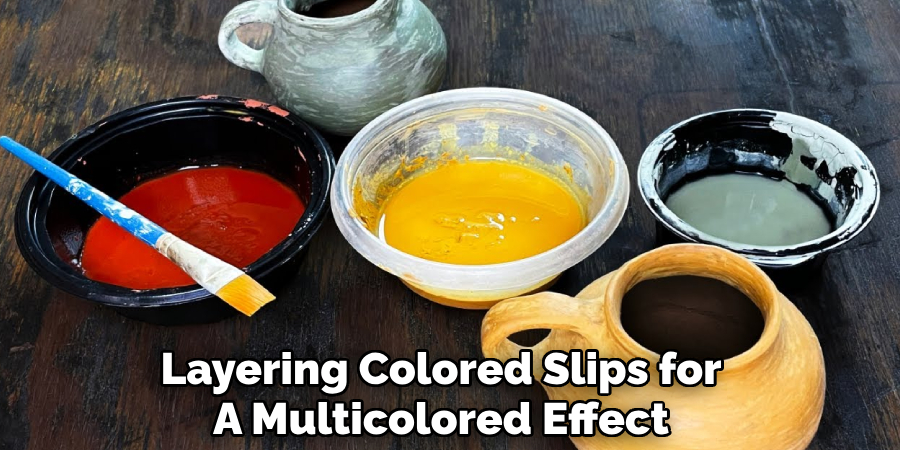
Allow each layer to dry slightly before applying the next, ensuring that each layer stays intact while building a textured or multicolored surface. You can either brush on the slips, dip the piece into different colored slips, or use a spray bottle for a more gradual color transition.
8. Using Colored Slip for Slip Trailing
Slip trailing is a technique where a colored slip is applied in a controlled, decorative manner using a squeeze bottle or a piping bag. To make colored slip for trailing, first prepare your slip by mixing your chosen colorant into the clay and water mixture.
Once you have the slip at the right consistency, load it into a squeeze bottle or piping bag. Practice trailing the slip onto a piece of test clay to get a feel for the flow and control of the slip. Use the slip trailing technique to create intricate designs, raised patterns, or freeform lines directly on your pottery surface.
9. Making a Colored Slip for Marbling Effects
Creating a marbled effect with colored slip involves combining different colored slips in a swirling pattern to produce a striking visual effect. To do this, prepare several colored slips by mixing stains or oxides with water and clay. For the marbling effect, start by spooning or pouring different colored slips onto a flat surface or directly onto your piece.
Use a tool, like a skewer or needle, to swirl the different colored slips together, creating organic, flowing patterns. This method is particularly effective for making bold, abstract designs and can add a unique, handmade aesthetic to your pottery.
10. Making Slip from Colored Clay Bodies
If you’re looking for a more seamless integration of color and clay, you can use colored clay bodies to create your slip. Colored clay bodies are pre-mixed clays that come in various colors, from deep reds to earthy yellows, and can be used to make slips.
To create a slip from colored clay bodies, add water to the colored clay body and mix it until you achieve a smooth, thin consistency. This method results in slips that perfectly match the color of the clay body and can be applied without the need for additional stains or pigments.
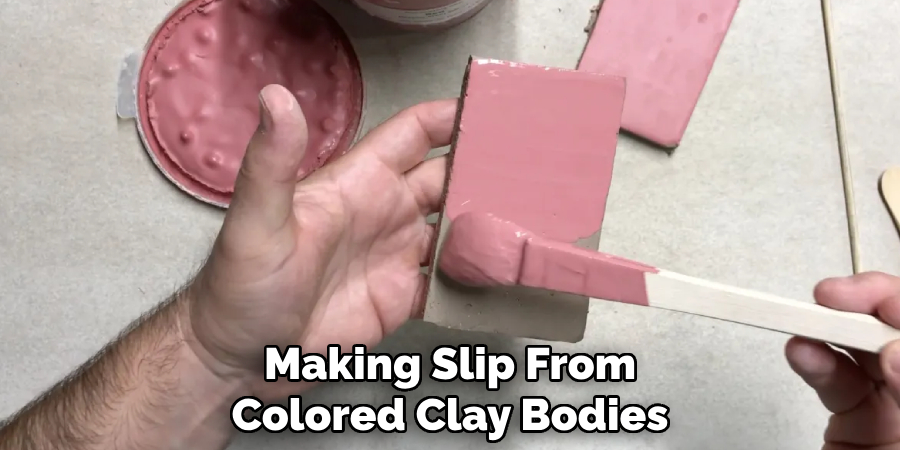
Conclusion
Making colored clay slip is an essential skill for potters and ceramic artists, enabling them to add depth, texture, and unique visual elements to their pieces. Whether you’re mixing stains, oxides, or natural pigments, or employing techniques like slip trailing, sgraffito, or marbling, the possibilities are endless.
By experimenting with different colorants, tools, and application methods, you can discover new ways to personalize and enhance your clay projects. Colored slips are an excellent way to incorporate both decorative flair and functional beauty into your pottery creations. So, there you have it – a quick and easy guide on how to make colored clay slip.
Specialization:
- Master of wheel-throwing, hand-building, and advanced glazing techniques
- Focus on creating both functional pottery and decorative art pieces
Recognition:
- Celebrated by collectors and art enthusiasts for creating one-of-a-kind pieces that blend artistry with functionality
- Participates in local and national exhibitions, earning accolades for his innovative designs and craftsmanship
Passion:
- Deeply committed to exploring and pushing the boundaries of ceramic artistry
- Continuously experiments with new materials, firing techniques, and artistic concepts to evolve his craft
Personal Philosophy:
- Believes in the transformative power of art, aiming to evoke emotions and connections through his ceramic creations
- Advocates for sustainability in ceramics, using eco-friendly materials and practices whenever possible


